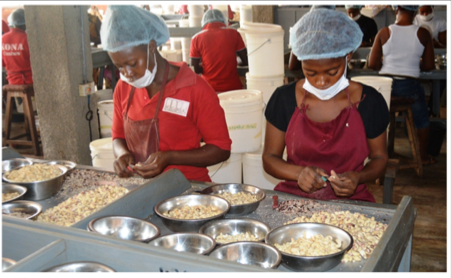Cashew is an economic tree that produces apples and nuts. Cashew is largely cultivated in the forest-savanna transitional zone, covering parts of Ashanti, Bono, Bono East and Savanna Regions.
Over the years, cashew farming in the country has seen many interventions, aimed at increasing production and productivity. Some of the interventions include the Economic Recovery Programme (ERP) in 1983, under which cashew was identified as one of the major non-traditional crops, penciled for development to cushion the government’s diversification of export commodities agenda then.
Fast forward to 2002, there was an implementation of the Cashew Development Project (CDP). The project marked the first major attempt by the government for a well-developed and coordinated activities in the sub-sector. In between the 80s and 2002, few and isolated efforts were made by some individuals, private companies and non-governmental organisations (NGOs) to promote the cashew industry in Ghana.
In February 2017, a ten-year Cashew Development Project was also launched at Wenchi in the Bono Region. The plan which was launched by the President Nana Addo Dankwa Akufo-Addo seeks to improve research methods, introduce appropriate production and processing technologies, as well as develop marketing strategies along the value-chain. The aforementioned interventions among others have over the years contributed to an increased cashew production and productivity.
It is not surprising that the country continues to enjoy reasonable export earnings from cashew trade. According to the Ghana Export Promotion Authority (GEPA), cashew is the leading non-traditional export (NTE) commodity in the country. Statistics indicate that in 2018 cashew fetched the country US$378.21 million, representing 43.84 percent increase from US$263.95 million in 2017. The chunk of the export earnings were derived from shipment of raw nuts.
Cashew processing
Notwithstanding the benefits the country enjoys from the cashew value chain, especially export earnings from RCN, there are huge untapped opportunities which could be maximized. One area in the cashew value chain which remains underutilized is processing in the country. However, there are challenges undermining the full potential of cashew processing.
Cashew processing is a very simple and straight forward endeavour/activity. For a country like Ghana situated within the cashew growing region/belt, it is very obvious that cashew growing and processing should be encouraged and supported by the government. Cashew processing is in effect a low hanging fruit that should be picked. Cashew processing involves processing of fruit into juices or alcohol, processing of nut or seed to extract the kernel and the processing of the raw nut to extract the cashew nut shell liquid (CNSL). The cashew nut shell can also be processed into particle or chip board or used as biomass fuel to generate electrical power. Some progress has been made in processing the nuts but it terms of the fruits, the least said the better.
There are existing processing companies (both large and small scales) in the country who are struggling to make impact in the sub-sector; they are made up of indigenous and foreign-owned firms. Some of the companies are USIBRAS Ghana Limited, Mim Cashews and Agricultural Products Ltd., Kona Agro processing Limited, Kabile Cashew Farmers’ Cooperative Company, Nimdee Hyren Company Limited, Nafana Agro Processing Company, Agroking Limited, Gensap Ventures and Innov. Organic Limited.
Challenges in cashew processing
Cashew processing in country is bedeviled with plethora of challenges. The situation has forced some of the companies to halt business, while the rest operate below their installed capacities. For instance, Kona Agro processing Limited, an indigenous firm at Awisa near Wenchi which started operation in 2008 got shut down in 2015. USIBRAS Ghana Limited at Prampram in the Greater Accra Region on the other hand has installed capacity of 30,000 metric tonnes per year but currently, its produces around 15,000 to 20,000MT. The troubled state of the factories has resulted in massive job losses and investments.
Access to raw cashew nuts
Access to raw cashew nuts for processing has been a challenge faced by processors. There is an unhealthy competition for the raw commodity. It is fuelled by excessive export of RCN to countries like India and Vietnam. The excessive exportation of RCN is not only prevalent in Ghana but across cashew producing countries in Africa, thereby starving local processing companies. Africa in 2016 produced about 1.55 million MT of raw cashew nuts, of which 90 percent was exported. The remaining 10 percent was woefully inadequate to meet the raw material requirement of local processors (ISS, 2016).
In an interview with the B&FT, Managing Director of Kona Agro processing Ltd., Raymond Kojo Opoku Taylor, said the situation in Ghana is worse than other producing countries such as Cote d’Ivoire and Burkina Faso and demanded pragmatic measures to salvage the situation.
Ivory Coast is the world largest producer of RCN with close to 800,000MT per annum. However, they have an extremely regulated industry. Buying is reserved for Ivorian nationals who are licensed. This means foreign buyers play a very limited role in the purchase of RCN and are not permitted to purchase raw cashew nuts at the farm gate. On the contrary, in Ghana the industry is not regulated and as such, foreigners are able to purchase RCN at the farm gate. This situation means most foreigners always flood the local market, creating unhealthy competition to push RCN price up to the disadvantage of processors.
Ivory Coast and other West African countries like Benin have implemented export tariff on RCN. This places a limit to what exporters will be willing to pay for RCN since the export tariff will be added to the final price. “If adopted, this policy will harmonise RCN prices and put local processors in a competitive advantage. At the moment India is the world’s biggest market for consumption of cashew kernels however this market is not accessible to processors from outside India because of high tariffs on imported cashew kernel,” Mr. Taylor advocated.
Sometime ago, authorities in the country initiated steps to introduce Cashew Export Levy as it pertains in other countries. Formulation and implementation of the Cashew Export Levy reached an advance stage before it was later dropped. Checks at the GEPA revealed that the soon-to-be inaugurated Tree Crops Development Authority will have the mandated to formulate such laws, hence the freeze on the initial steps.
A small-scale processing firm, Kabile Cashew Farmers’ Cooperative Company at Kabile near Sampa in the Jaman-North District of Bono Region has an installed capacity of 280 metric tonnes but it produces about 120mt/year. The Manager of the Company, Matthew Kwadwo Sah, said due to high prices of RCN, the company relied heavily on hire-purchase for RCN, thus contributing to underproduction.
High capital requirement
To establish a cashew processing factory, it requires substantial investment for infrastructure including factory buildings, warehouses and industrial equipment. Besides, there is the need for working capital to purchase RCN within the cashew harvesting season to stock to be able to process throughout the year, and cater for overheads. The high capital investment required makes it inevitable that the annual throughout that guarantees positive economic returns increases.
The MD of Kona Agro processing Ltd. said “with an annual throughput of 1,000MT, it requires US$1million; at a throughput of 3,000MT, it increases to US$3million per annum. The breakeven throughout for cashew processing has increased from 1,000MT per annum to 3,000MT. Increased mechanisation has meant the labour required to process 1,000MT per annum had decreased from 330 to approximately 100. But to process larger volumes to maintain breakeven means labour remains relatively constant with better wages due to higher productivity, making is difficult for processors.”
High labour cost & mechanisation
The availability of competitive labour is an important element in an efficient and effective cashew processing sub-sector. It is imperative for factories to train, attract and retain competitive workforce to sustain business. Whether to use a labour-intensive processing method or mechanised/automated is moot. Current industry conditions are such that cost of labour in Ghana is relatively high and the competitive advantage as well as increased efficiency of new machines make it inevitable for processors to use mechanised production methods.
As it stands now, the real question is choice and origin of technology. Indian, Sri Lankan, Vietnamese or Italian. From a value for money and efficiency perspective, Vietnamese equipment are leading. Vietnamese machines that are well calibrated and maintained can deliver a percentage whole of 65% and some element of manual processing to provide a fine balance. Processors say the choice of industrial equipment must reflect a fine balance between throughput of RCN and kernel output in terms of percentage wholes and broken. Whole nuts are more valuable and fetch higher prices. Labour intensive processing can attain a percentage whole of 75 – 80% whereas mechanised processing ranges from 40 – 60% wholes. The underlying factor here is the cost element.
OPPORTUNITIES IN CASHEW PROCESSING
The global cashew market has seen significant growth in recent years. It is estimated that the market grows between 7-10% annually, thus creating different opportunities along the cashew value chain. Adoption of healthier lifestyles, particularly in Europe and America has boosted the consumption of cashew, hence expansion of the market.
Industrial Job creation
The surge in demand for cashew kernels and other products across the globe translates into corresponding supply increase. To meet the year-on-year-on demand, processing factories must also increase production and productivity which will eventually create more employment opportunities. USIBRAS Ghana Limited which has a processing capacity of 30,000MT, processes between 15,000 to 20,000MT and employs 600 people. Should the company scale up production to its optimal capacity, it is likely to increase workforce to over 1,000.
Defunct Kona Agro processing Ltd. is seeking investment partners to reopen the factory in soonest time. The expected revived company is estimated to create 500 direct jobs in the first year and increase to 1,000 in the subsequent years when production increases. About 80% of the workers would be women.
Farm growth & development
The impact of a competitive cashew processing sector would ultimately increase the demand for raw nuts. Amidst an increase demand for raw material, producers (farmers) would be required to expand production and productivity to satisfy the needs of processors by expanding existing farms, replace old and non-productive trees and create new farms. This will also increase the incomes of farmers and farm workers as well.
Foreign Direct Investment
Cashew processing is a profitable venture. If cashew processing is properly structured and well-positioned in the country’s agribusiness space, it would become an attractive investment venture for prospecting investors across the globe. The sub-sector has gross margins range between 30-40%with return on investment achieved within 3-5 years (ISS, 2014). It remains a viable avenue that authorities should utilize to attract more foreign direct investment (FDI).
Support for sector
The GIZ Competitive Cashew initiative (GIZ/ComCashew), an international development project in the cashew value chain has opted to support some of the cashew processing companies. It has been assisting processors with capacity building in the areas of access to finance, market entry training, quality management with regards to sourcing and warehousing of RCN as well as good manufacturing practices.
In the quest to address the challenge of access to finance, four processing companies have been assisted with the development of business plans. GIZ/ComCashew is currently profiling concessional finance providers in a bid to source funding for cashew processors. The concessional finance is expected to bridge the gap between the present state of small-scale cashew processors and their ability and eligibility to take on commercial finance. In order to improve upon efficiency, GIZ/ComCashew is also working around the clock to upgrade the equipment of six local processors.
Kabile Cashew Farmers’ Cooperative Company, Nimdee Hyren Company Limited, Nafana Agro Processing Company Limited, Agroking Limited, Gensap Ventures and Innov. Organic Limited are the beneficiaries’ companies of GIZ/ComCashew support to the industry.
Conclusion
The absence of a national policy on cashew is the major bane of the industry. A national policy is required to drive innovations for urgent introduction of regulations on purchasing, trading and export of RCN among others so as to transform cashew processing in the country. It is highly anticipated that the much-awaited Tree Crops Development Authority, which is expected to be inaugurated before the year ends will indeed champion the course to change the fortunes of cashew processing.










